The Arno river cuts Florence into two parts: the right side and the left side.
Right bank
The tour starts from San Niccolò bridge (buses nr 13 – 14 – 8). Many tourist buses stop here; along the river there is a little multiethnic market. This tour is very like the “Bridges tour” so you can read the description of the bridges in that section. Here is the description of what you can see along the “Lungarni” (along the Arno river path) between one bridge and the next one.
Following the course of the river, you are in the “Lungarno Pecori Giraldi” on the right you see the Barracks Baldissera (1909) a little further on you are in Piazza Piave with the tower of the “Zecca Vecchia” which was part of the last Florentine Circle of Wall. Here the river is crossed by a weir – Pescaia di San Niccolò –
Proceed along the “Lungarno della Zecca Vecchia” and arrive in Piazza Cavalleggeri.
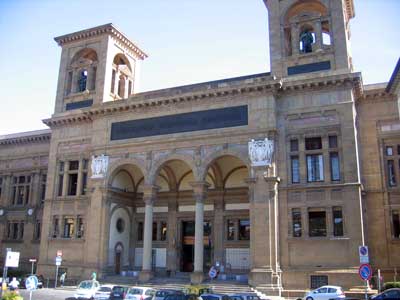 Here there is the Central National Library built in 1911/1935 by Cesare Bazzani.
Here there is the Central National Library built in 1911/1935 by Cesare Bazzani.
In this place once there were Barracks. Before since 1714 the National Library had been in the Palace of Dogana , it was named Biblioteca Magliabechiana and had about 30,000 publications and MS. Over the centuries it was enriched by the donations of the libraries of the main Florentine Families such as Medic, Strozzi Guicciardini.
There are more than 85 km. of metal shelves, 24721 manuscripts, about 1 million letters and documents, about 6000 volumes and music papers, 630 different atlas, 14754 maps. Many original codes of Dante’ s works, Galileo works, just to remember the two most known figures.
Along the Lungarno delle Grazie you arrive at the Bridge “Alle Grazie”. The bridge’s name was once “Rubaconte” (from the name of Rubaconte da Madello who laid the foundation stone in 1237). The current name comes from a Chapel which was consecrated to the Lady. This chapel was located on the river and was demolished in the past century.
Also this bridge was destroyed by the German Army in the last war and rebuilt in 1957.
On the other side there is the palace “Alberti Malechini” (nr 1 of Via de’ Benci).
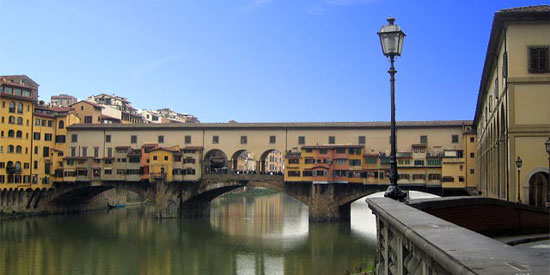
Going on, on the right you find Piazza Mentana and then Piazza de’ Giudici with the History of Science Museum which is in the Castellani Palace (2nd half of XIV century). Once, from 1574 to 1841, this palace was used by the Magistrates of Civil Suits, from here the name of the Square (Giudici = Magistrates). Near the Museum the most famous museum of Florence: Uffizi Gallery. Now you are in Lungarno degli Archibusieri which runs under the “Corridoio Vasariano” the over passage the Madici Family used to move from Palazzo Vecchio to Palazzo Pitti. The passage runs also over the Old Bridge.
In 1333 a flood destroyed the only bridge on the river Arno in Florence. This was not the first time: also in 1117 a flood had destroyed the bridge.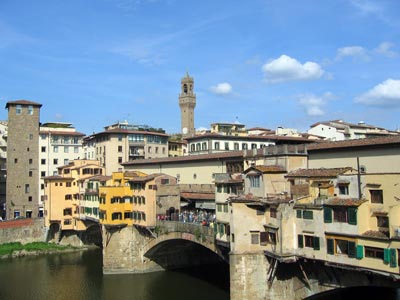
On July 18th 1345 the new bridge was finished: its 43 little shops brought to the Commune 80 golden Florin a year. It was at the same time, a bridge, a market and a square.
Even today with its extraordinary architectural and urban features, the Old Bridge is a symbol of Florence
The bridge crosses the river in its narrowest point and it is the oldest bridge of Florence. It has three bays and it is so wide that it contains two porticoes with shops that once were butchers’ or greengrocers’. At the end of 16th century, Ferdinand the 1st settled goldsmiths and jewelers in the shops.
This bridge was the only one which the German army saved from the bombs.
The big flood in 1966 injured the bridge very much and also the shops, so that many jewels were lost.
 In the center of the bridge you find a square overlooking the river, on the right there is a fountain with Benvenuto Cellini bust made by Raffaello Romanelli in 1900 On the left on the arches, Giorgio Vasari built the Corridoio Vasariano (Vasari’s Passage) on behalf of Cosimo the 1st Medici. The passage was built to allow the crossing of the river from Palazzo Vecchio and Uffizi Gallery to Pitti Palace. At the end of the bridge there was (and there is still now) the Tower of Mannelli family, who opposed Vasari’s project to destroy the tower, he was therefore compelled to build the passage around the tower.
In the center of the bridge you find a square overlooking the river, on the right there is a fountain with Benvenuto Cellini bust made by Raffaello Romanelli in 1900 On the left on the arches, Giorgio Vasari built the Corridoio Vasariano (Vasari’s Passage) on behalf of Cosimo the 1st Medici. The passage was built to allow the crossing of the river from Palazzo Vecchio and Uffizi Gallery to Pitti Palace. At the end of the bridge there was (and there is still now) the Tower of Mannelli family, who opposed Vasari’s project to destroy the tower, he was therefore compelled to build the passage around the tower.
From Ponte Vecchio to the next bridge you walk in Lungarno Acciaioli which is on the oldest street along the river in Florence. The oldest building in this part is the Consorti Tower, XI century. On the back there is the apse of the Church of SS. Apostoli (XI century) a real jewel of this part of the town (see description in the section “Piazza della Repubblica”).
At the end of Lungarno Acciaioli on the right there is the beautiful big Palazzo Ferroni (13th century) on the left hand the Very beautiful and elegant Ponte a Santa Trinita.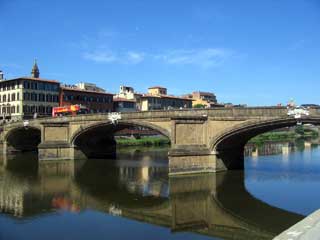
Built in 1257 this bridge, has been reconstructed many times due to frequent flooding and to the damage of German bombs in 1945 during the second world war. It was rebuilt in the same shape planned by Ammannati, who realized an idea from Michelangiolo.
In Lungarno Corsini at nr 2 there is Gianfigliazzi Palace and at nr 10 Corsini Palace built by Pier Francesco Silvani (1648/56). Inside the palace the Corsini Gallery (visit only by appointment phone 055218994) very interesting pieces of Florentine painting in 1600/1700.
Last palace before the next bridge: Ponte alla Carraia, is Ricasoli Palace by Michelozzo – 1480.
This bridge was first built in 1218 it felt down in 1333 under the weight of the people who was looking at a regatta.
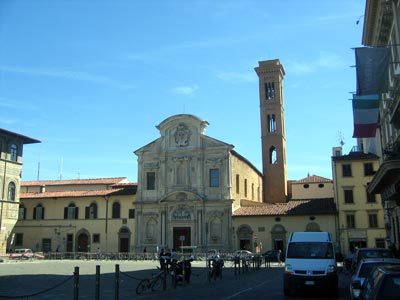 Now leave the route along the river to take Borgo Ognissanti to get to Piazza Ognissanti. A fun house “upside down” is at nr.12 because of the consoles built upside down. In Liberty style, very unusual in Florence, the S. Giovanni di Dio Hospital
Now leave the route along the river to take Borgo Ognissanti to get to Piazza Ognissanti. A fun house “upside down” is at nr.12 because of the consoles built upside down. In Liberty style, very unusual in Florence, the S. Giovanni di Dio Hospital
- nr 20 - Now the beautiful Piazza Ognissanti, a nice terrace on the river, with palaces (now five stars Hotels), the precious Church of Ognissanti (1251) and an amazing view on the other side of the river with the Church of Cestello.
If you like you can go on to the American Consulate and then to the Cascine Park. On Tuesday morning there is a big market in the Cascine park along the Arno.
LEFT BANK
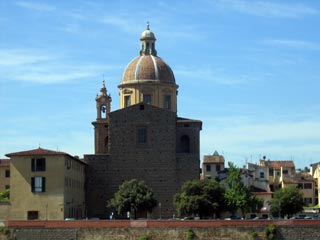 This route starts from Piazza Francesco Ferrucci, near Ponte San Niccolò walk down to Lungarno Benvenuto Cellini as far as Piazza Poggi. Here you can see the Porta San Niccolò (1324). Three equal buildings form a sort of theatre in this square, near the door ramps climb up to the hill of Piazzale Michelangelo, along the route there are fountains and grottos. You can visit Piazzale Michelangelo now, or you can also go there by bus (nr 13 from Santa Maria Novella train station). You’ll find the description of Piazzale Michelangelo at the end of this section. From Piazza Poggi the main route goes on in Via San Niccolò the old “via del Borgo” which still now has the typical look of the streets of the 14th century. On the left a short street goes to San Miniato gate (14th century)and then goes up to the Church of San Miniato (do not miss it when you visit Piazzale Michelangelo!). On the right there is the ancient Church of San Niccolò Oltrarno, built in 1184 and restored several times (in 1374 and then by Vasari in the 16th century). On the left hand of the façade, a memorial tablet reminds the flood of 1557 and the level of the water in the flood of 1966. Along San Niccolò there are lots of historical palaces such as Palazzo del Rosso Vitelli (nr 54), and a tower house (nr 87). The street enlarges in Piazza dei Mozzi with three palaces which date back to the 13th century. In the 19th century these palaces were bought by the antique dealer Stefano Bardini to keep his collection of antiquities as private museum. In 1922 the Bardini Museum vas given to the town of Florence. Soon you’ll be able to visit the museum which at the moment is closed. In this square there are two more palaces:
This route starts from Piazza Francesco Ferrucci, near Ponte San Niccolò walk down to Lungarno Benvenuto Cellini as far as Piazza Poggi. Here you can see the Porta San Niccolò (1324). Three equal buildings form a sort of theatre in this square, near the door ramps climb up to the hill of Piazzale Michelangelo, along the route there are fountains and grottos. You can visit Piazzale Michelangelo now, or you can also go there by bus (nr 13 from Santa Maria Novella train station). You’ll find the description of Piazzale Michelangelo at the end of this section. From Piazza Poggi the main route goes on in Via San Niccolò the old “via del Borgo” which still now has the typical look of the streets of the 14th century. On the left a short street goes to San Miniato gate (14th century)and then goes up to the Church of San Miniato (do not miss it when you visit Piazzale Michelangelo!). On the right there is the ancient Church of San Niccolò Oltrarno, built in 1184 and restored several times (in 1374 and then by Vasari in the 16th century). On the left hand of the façade, a memorial tablet reminds the flood of 1557 and the level of the water in the flood of 1966. Along San Niccolò there are lots of historical palaces such as Palazzo del Rosso Vitelli (nr 54), and a tower house (nr 87). The street enlarges in Piazza dei Mozzi with three palaces which date back to the 13th century. In the 19th century these palaces were bought by the antique dealer Stefano Bardini to keep his collection of antiquities as private museum. In 1922 the Bardini Museum vas given to the town of Florence. Soon you’ll be able to visit the museum which at the moment is closed. In this square there are two more palaces: 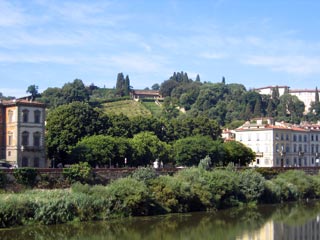
Torrigiani-Nasi (nr 5) and Lensi-Nencioni (nr.3) and the Mozzi-Bardini Garden (entrance in Via de Bardi nr 1, or Costa San Giorgio 4, if you come from Boboli Gardens) nestled between the river and the hill of Piazzale Michelangelo; this spectacular garden has been recently restored, it is a real jewel and worth a visit.
The Church of Santa Lucia dei Magnoli is also called “Delle Rovinate” (The crashed down houses) in memory of a big landslide which in 1547 destroyed 18 houses. From Piazza dei Mozzi you have to go back into Via de’ Renai and then into Via of Serristori Gardens, just to have an idea of how this beautiful garden which once was along the river looked like. Now go to the Lungarno Serristori and walk down to Piazza dei Mozzi along the Arno. On the left, (nr. 3) you can find the House of Rodolfo Siviero (free entrance, nice volunteers show you many pieces that the owner (Rodolfo Siviero) saved from the nazi in the last world war. Going on along the river you can rest a while sitting on a garden seat of Piazza Demidoff. After short time you are in Piazza dei Mozzi again.
After the church there is the big Palace Canigiani (nr 28 and 30) and the imponent Capponi Palace (nr 36 and 38) with beautiful ashlars on the lower pat of it . Via dei Bardi joins the Lungarno Torrigiani in Piazza Santa Maria Soprarno, and get to the entrance of Ponte Vecchio. Before the bridge the Mannelli tower is one of the four towers which were at the bridge’s entrances.
The street passes under the Corridoio Vasariano. The Vasari Corridor, as you know, starts from Palazzo Vecchio, crosses the river, and arrives to Pitti Palace. If you stay enough in Florence to visit this corridor, you’ll see how Vasari cut a part of a pre-existent church (Santa Felìcita) without injuring it but on the contrary, creating an amazing effect. On the left you have Santa Felicita and the Via Guicciardini which leads to Pitti Palace and Boboli Gardens (this route is in the “Oltrarno tour”).
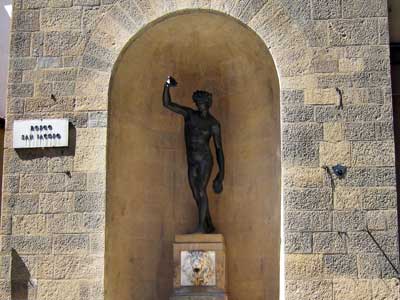 Now we take Borgo San Jacopo. As you surely noticed, this part of Florence has very ancient buildings, as tower houses, together with modern building. This is the effect of the last world war, when this part of the town was heavily bombed. Anyway you can still admire many tower houses. At the beginning of Borgo San Jacopo, there is the ancient road which from Pisa lead to the only bridge of Florence: the Old Bridge. The fist tower is the Rossi-Cerchi one, on the base the Bacchino Fountain with a statue by Giambologna on a marble fountain.
Now we take Borgo San Jacopo. As you surely noticed, this part of Florence has very ancient buildings, as tower houses, together with modern building. This is the effect of the last world war, when this part of the town was heavily bombed. Anyway you can still admire many tower houses. At the beginning of Borgo San Jacopo, there is the ancient road which from Pisa lead to the only bridge of Florence: the Old Bridge. The fist tower is the Rossi-Cerchi one, on the base the Bacchino Fountain with a statue by Giambologna on a marble fountain.
Then there are the towers of Belfredelli and Ramaglianti, and in front of them the Barbadori tower. At the number 17 Marsili tower, and a little further the Angiolieri tower. Few steps on there is the Church of San Jacopo sopr’Arno (X century).
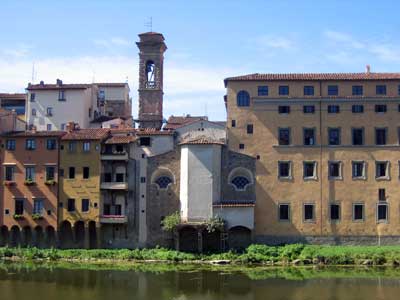
Near the church an old monastery leads to Piazza Frescobaldi and the Frescobaldi Palace. On the corner of Borgo S. Jacopo and Via dello Sprone there is the beautiful fountain by Buontalenti.
On the corner with the river the palace of Padri delle Missioni. Now we are in front of Santa Trìnita Bridge, this Lungarno is “Lungarno Guicciardini”, Many palaces of this Lungarno maintain their façade and entrance in the back part of Via Santo Spirito, such as Capponi Palace (nr 1), Coverelli and Guicciardini Palace, (nr 7), then, Lafredini Palace and Soderini Palace.
Along Lungarno Soderini there is the “Seminario Maggiore” (nr 19) which once was a monastery and then in front of Piazza Ognissanti which is on the other side of the river, there is the Cestello square, with the unfinished façade of San Frediano in Cestello Church(1680-89) and its nice, elegant dome by Antonio Maria Ferri. The Lungarno Soderini ends with the 14th century walls and the Santa Rosa Tower. Here a tabernacle with a fresco representing a Pietà by Ridolfo del Ghirlandaio.
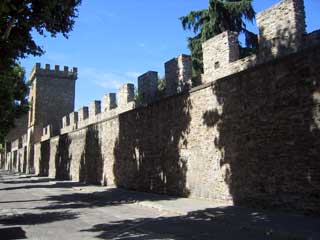
This tour ends with the 14th century gate: Porta a San Frediano. Just behind this gate on the right, a little simple trattoria where you can taste typical Florentine food (NB it is not sure you can choose what eating, maybe the owner decide for you, or they have only one or two choice, but it is worth trying!)

You must be registered to post comments.